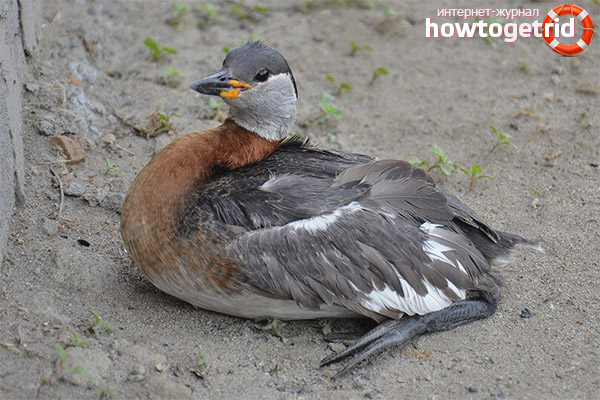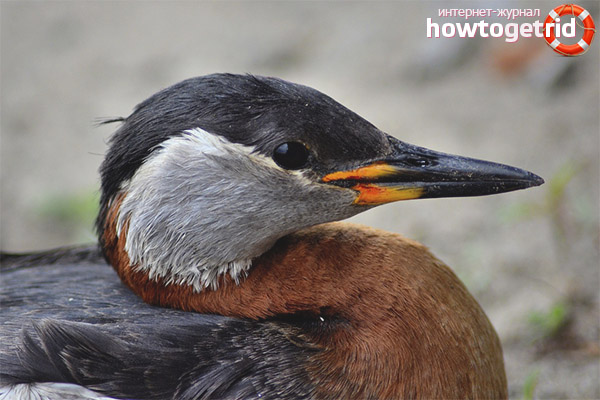The content of the article
- Latin name: Podiceps grisegena
- Squad. Lemping. Podicipediformes
- Family. Reed Podicipedidae.
- Status. 1 category. A threatened species.
- Rank guard. Local.
Geography habitat
In the central part of Russia, the range of representatives of these birds reaches Arkhangelsk. In the Yaroslavl region is part of the nesting area. Seroschekaya grebe settles on the site of the Rybinsk reservoir belonging to the Darvinsky Reserve. Birds were also met in the floodplain of Lake Nero and on the Ukhra River. Flying representatives of this species were repeatedly noticed on the lakes of the Nekrasovsky District and Lake Plescheevo.
In addition to the European part of Russia, gray-necked grebe settles on the reservoirs of Western Siberia. Individuals of this species can be found on Kamchatka, its representatives even go over 69o north latitude in eastern Siberia.
Gray-necked grebe is distributed in the territory of Western Europe from Denmark and Holland, and it can also be found in the waters of North America. In the east, representatives of this species can be seen in Kyrgyzstan, Kazakhstan and in the territory of the People's Republic of China.
Gray-necked grebe is a migratory and wandering species. Birds prefer to winter on the coast of the North Atlantic and on the northeastern shores of the Mediterranean Sea, sometimes reaching Italy.
Population size
Description of the characteristics of the species
The size of the representatives of the “gray-cheeked grebe” is average, as in the case of an ordinary urban pigeon. The beak is straight, long, closer to the conical shape. The color of the beak is black with a transition to yellow at the base. The color of feathers on the body of the bird differs: it is dark on the back, and white on the belly. The head of the bird is black on top, and the throat and cheeks are highlighted by a lighter coloring of feathers. During the flight of the gray-toed grebes, you can see the white spots on the wings.
In the mating season, the color of the gray-cheeked toadstools changes - a red-brown coloration appears on the neck, slightly approaching the upper thorax of the birds. The coloring of males and females does not differ.
Living Conditions and Lifestyle

Gray-necked grebe, as a rule, prefers to settle in groups or in pairs. For nesting birds choose small ponds with a large number of thickets of aquatic plants. Individuals can make a nest both on the lake and in a swamp or an overgrown pond. Large natural water bodies and reservoirs of birds rarely choose for their nesting, regardless of the degree of development of aquatic vegetation.
Representatives of this type of waterfowl are rather silent and secretive. Adults avoid the open space of water and prefer to move in the thick of the reed and cattail beds to be safe. However, during mating games, seroscheisky grebes begin to make a lot of noise with their loud cries. Males perform ritualistic mating demonstrations in the twilight darkness.
Arrangement of the nest future parents produce among the thickets of sedge plants, at shallow depths. The nest is located in the water and is attached to the bottom of the base. In rare cases, toadstools make a nest floating, and attach it to plants.
Egg laying pair incubates together. The eggshell is dull, off-white, with a bluish or greenish undertone. In broods, as a rule, from 2 to 6 chicks. They are able to stay on the water from the first moment of life, but for safety, the parents move their cubs on their backs. Immediately after the birth of the chicks are not removed from the native nest. After a few days, young grebes begin to actively master swimming, moving throughout the reservoir. Reach the age of youngsters, as a rule, no more than 3 chicks.
As food birds consume fish, as well as small amphibians. Aquatic invertebrates and plants constitute a small part of the diet of seroschekly toadstools. The bird feeds mainly from the surface of the reservoir or, diving to a small depth. The maximum diving time of the seroschekih toadstools does not exceed 30 seconds.
Population constraints

Gray-necked grebe is less and less common in habitual habitats due to the active distribution of tourist recreation in its nesting sites. Reservoirs inhabited by toadstools are actively visited by people who frighten the birds with their noise and bustle.
The second negative factor in reducing the serosca population of the toadstool is autumn bird hunting. At the time of migration, representatives of birds are especially noticeable and vulnerable to hunters.
Recommendations for the conservation of the species in natural conditions
- Protection of well-known nesting sites of gray-necked grebes.
- Constant work on the search for new nesting areas with a view to their inclusion in the system of protection of this population.
- Strong propaganda among the local population visiting habitats.The purpose of explanatory activities is to convey to tourists and hunters the importance of protecting birds during the period of passage and nesting.
State security measures
Currently, representatives of this species are protected on the territory of the Yaroslavl region in two special natural zones. We are talking about the Plescheevo Lake National Park and the Darwin State Natural Biosphere Reserve.











To send